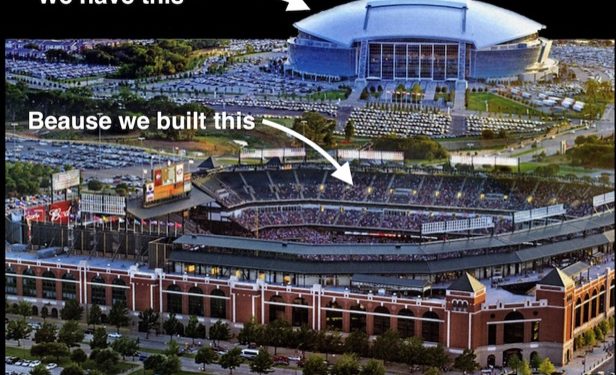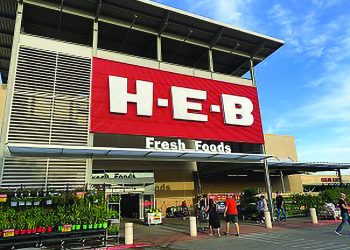While the Cowboys season again ended in disappointment, now is a good time to take a look at the silver lining beyond the wins and losses.
Arlington’s substantial economic benefit from being the team’s host city transcends what happens on the playing field.
AT&T Stadium has 80,000 seats and every one of them is sold out for every game before the season begins.
Another 20,000 or so show up with standing-room-only tickets a couple of hours before kickoff to get the best possible location in the concourse level end zone plaza areas. (WFAA News)
All of these 100,000 fans have spent significant money for their tickets, parking, concessions, and, for many, trips to the gift shops. Most of that spending includes local sales taxes that find their way directly into the city’s bank account helping to keep Arlington property taxes among the lowest in comparable cities across the state.
And, a great deal of all of that comes from non-Arlington residents That revenue is known as OPM or, “other people’s money” – a favorite objective for any city with any kind of visitor/tourism/sports economy.
Arlington’s is among the largest between the East and West coasts of the country.
We have reached the 20th anniversary of when Arlington voters produced a landslide decision to become the new home of what has been known since 1978 as “America’s Team.”
Here’s a reminder of how that came about.
With the old Cowboy Stadium in Irving having reached its end-of-life phase, Cowboy’s owner Jerry Jones began an earnest effort to find a city to partner with to create a new, world-class NFL stadium.
He always said his natural first choice was Dallas since his team had always born that city’s name. But that interest did not find favor with then Dallas mayor Laura Miller who was quoted as saying she was not in favor of taxpayers funding a “playground for rich guys.”
There’s a media report from that time where Jones and Miller were together at a luncheon and their conversation overheard when Jones reportedly said to her that he could “do this” in some other city. Miller’s response was reported as “you should go ahead and do it.”
Not long thereafter, Jerry invited me and former mayor Elzie Odom to a dinner event in his palatial Highland Park home. We were greeted with valet parking attendants and ushered inside for a short tour including the library where the Super Bowl Trophies were on display.
At the dinner table, I began pitching Arlington where I thought he could find the kind of success that had won overwhelming voter approval to build The Ballpark in Arlington in 1991.
Having paid off The Ballpark debt in less than half the time it had been first forecasted, the half-cent sales tax was again available to fund the city’s portion of a new Cowboy Stadium.
Jerry interrupted my exhaustive list of the things that define Arlington’s “can do” spirit and said, “I know all of that mayor. That’s why I’m coming to your city.”
In succeeding months, newly-elected Mayor Bob Cluck and Jerry worked out a 50-50 cost-sharing plan to build a new $650 million NFL stadium across the street from The Ballpark.
In the end, Jerry had expanded his new stadium to a cost of $1.3 billion. Arlington’s $325 million commitment remained firm as approved by voters resulting in a much more favorable deal for the city.
I know every Cowboy fan wants to see that Super Bowl Trophy raised again but, while we await such an outcome, Arlington has captured a major economic victory that just keeps on growing and growing.
Think of that when dealing with the dis-appointment of losing still another playoff game.
And be reminded that all of what has taken place in Arlington’s Entertainment District began with the wise decision of voters to keep the Texas Rangers right where they belong.















